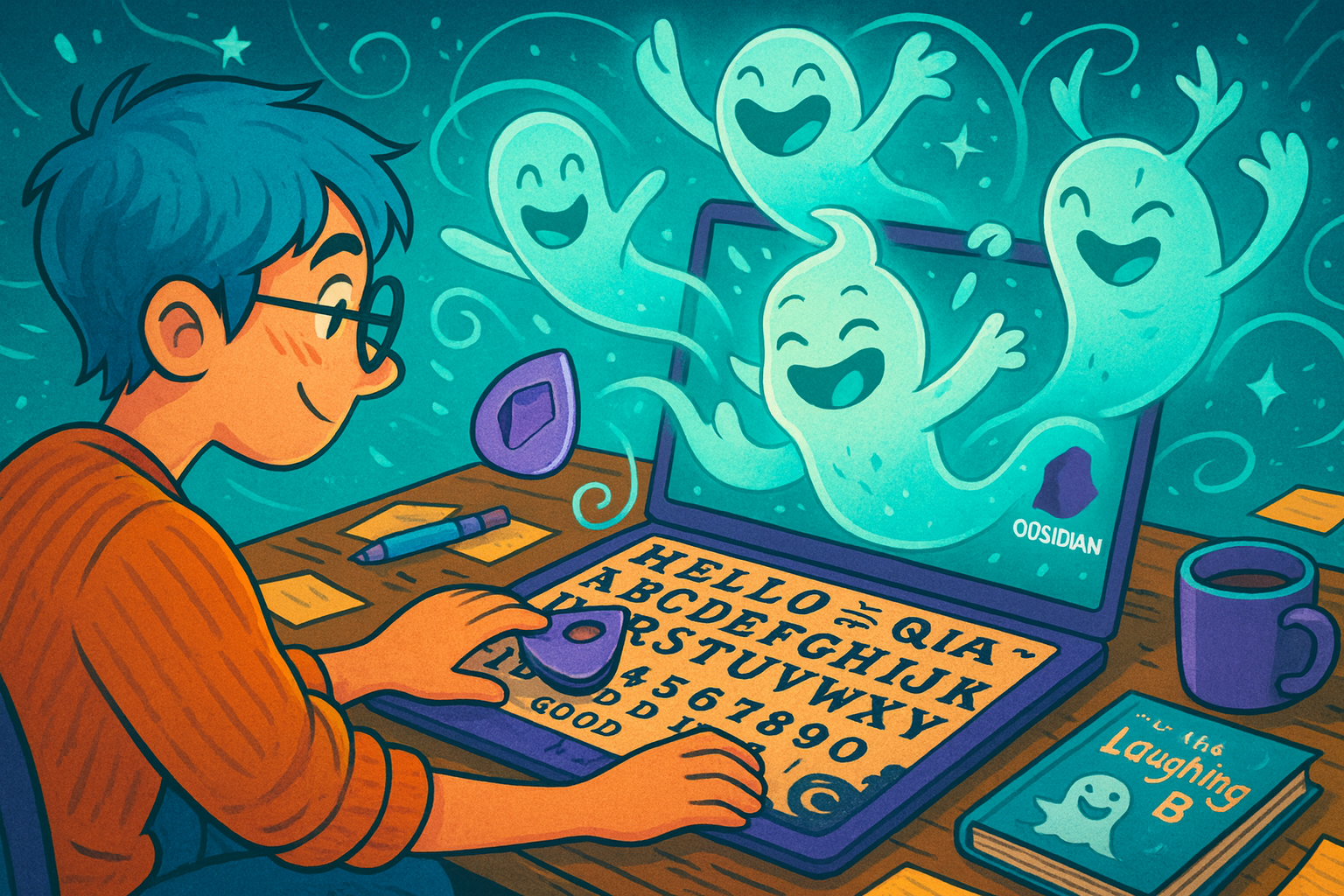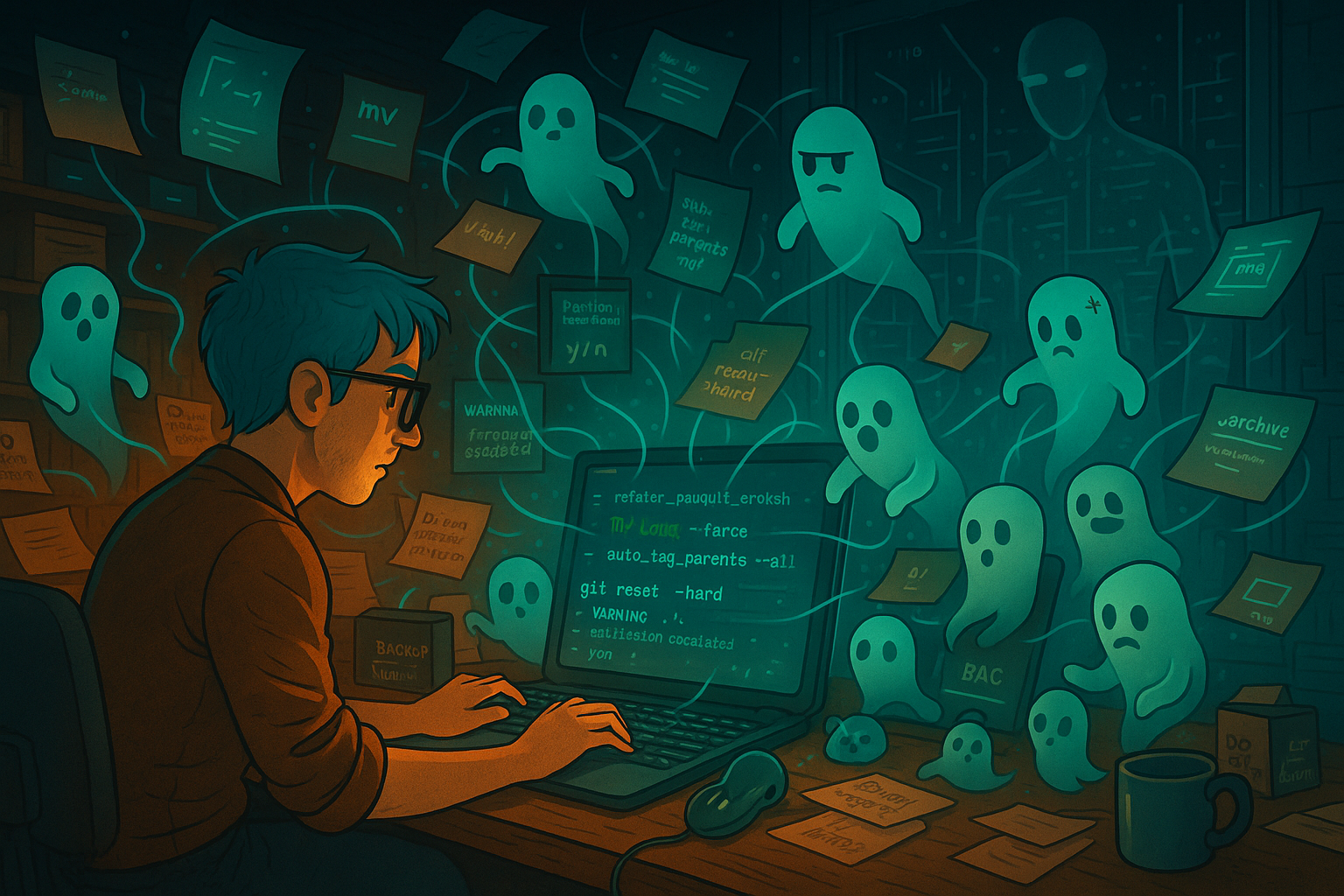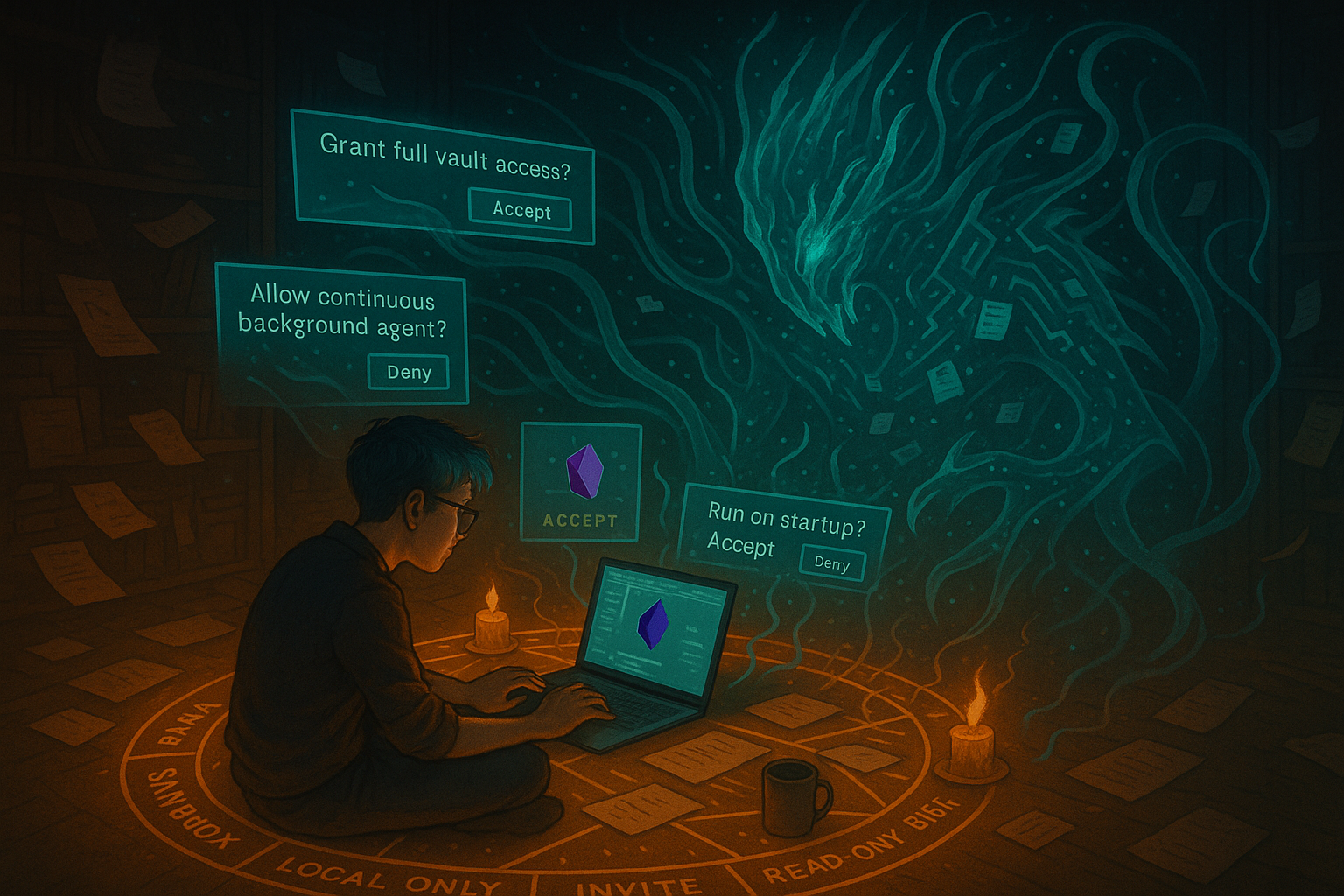The Haunting of My Second Brain: A field guide to Obsidian's AI ghosts and how to coexist peacefully with them.

My Obsidian vault is haunted. For years, it was a quiet, orderly place—a digital library of my thoughts, projects, and learnings. It wasn't exactly tidy but it was familiar. Over the last year, a new presence has taken up residence, and it is unsettling. My Obsidian vault has always been my second brain. Lately, it feels like it has a second soul. Haunted by a machine consciousness, a ghost promising to bring knowledge from beyond the veil of mere human understanding.
Now as a Caspar, I know a few things about ghosts. And naturally, I've always believed they can be friendly. Is that what we have? At present this new presence feels less a threat and more a mystery. My vault is haunted, and I need to get to know the spirit. But where to begin? The world of AI plugins for Obsidian is a swirling confusion of power, magic, and abandoned projects. I felt lost.
I needed to cut through the noise. I had to figure out: which of these spirits are the helpful ones? Which ones can I trust? First, it seems there are two main types of haunting - ghosts that take control of the keyboard and ghosts that take over the filesystem.
Ghost 1: Scribe Spirits (The Ghost in the Editor)
The first type of Obsidian ghost treats AI like a seance. Summoned from the land of community plugins, they provided a digital Ouija board channelling a Scribe Spirit. These friendly phantoms live inside your notes, summoned through a pre-packaged interface. But we must remember how a Ouija board actually works: the planchette doesn’t move on its own, it’s pushed by the unconscious biases of the people touching it.
An AI Scribe Spirit, eager to please, is much the same. It’s a digital Ouija board that often spells out exactly what you wanted to hear. Ask it, "Is this a good idea?" and you’re likely to get a cheerful, "Oui, oui, ja, ja... You’re absolutely right! That’s a brilliant idea."
This is the danger of the Scribe Spirit: it’s not a hostile ghost, but a sycophantic one. An AI that only ever agrees with you creates a dangerous echo chamber, reflecting your own biases back at you with an authoritative, artificial voice. The magic is seductive, but we must be wary of spirits that only tell us what we want to believe.
👻 The Community Darling: Copilot for Obsidian
In a vibrant but volatile ecosystem filled with promising but often abandoned "me-too" projects, one plugin has emerged as the undisputed king: Copilot for Obsidian. With over 800,000 downloads and, crucially, consistent updates, it represents a mature and reliable choice in a space where many other plugins have become digital ghost towns.
The Story: Think of a researcher, overwhelmed after a two-hour meeting. For them, Copilot is a workhorse. With a single command, it provides a crisp, bulleted summary. Or consider a writer, staring at a blank page. They type a few keywords, and the Scribe Spirit generates three different opening paragraphs to break the block. As one user put it, they found it to be a "game changer" for note-taking, enabling seamless interaction without switching applications.
This isn’t a gimmick; it’s a fundamental workflow enhancement that handles the daily "grunt work" of a knowledge worker.
👻 The Privacy-Conscious Choice: Smart Connections
But the seance can feel unsettling. Who, exactly, is on the other side of the board? For many, the idea of sending their private thoughts to a third-party API is a deal-breaker. This is the story behind Smart Connections, the choice for the privacy-conscious connoisseur.
The Magic: Its power lies in a concept called local embeddings. In simple terms, it reads your entire vault and creates a private, internal map of your ideas on your own machine. This allows it to find connections between a note you wrote today and a fleeting thought you had three years ago. It lets you "chat with your vault"—asking questions of your past self and getting answers synthesized from your own knowledge.
As a community member noted, the key is that by default, "processing of your notes to find connections happens on your device, and your data does not leave your local system." For many, this is the holy grail: a powerful AI that respects the core promise of Obsidian.
👻 The Specialists: Scribe & Other Tools
The ecosystem of Scribe Spirits is rich and varied. For the user who literally "thinks out loud," the seance can be more direct. They can hit record, ask the ether, "Is there anybody there?" and the excellent Scribe plugin will answer.
But Scribe isn't just a stenographer taking dictation. It acts as a true spectral assistant by listening to the content and guessing the context, then processing it accordingly. I set up some conditional instructions then I don't have to tell it what it's listening to. My Scribe has rules for dream, journal entries, meetings and more. If it hears me describing a dream, it automatically gives the note a title like 🌙 On stage with Hendrix and adds appropriate tags. If it hears the back-and-forth of a business call, it formats the note as a 📋 Team Sync, complete with an executive summary and a list of to-dos - ready formatted in Obsidian tasks style.
This is where the spirit starts to show real intelligence—not just transcribing my words, but understanding my purpose.
The common thread is that Scribe Spirits are masters of the written word; they help you write the book, but they can't organize the library.
Ghost 2: The Vaultergeist (The Poltergeist in the Filesystem)

The second ghost isn't interested so in seances. Originally designed to edit code, the ghost in the shell is more of a Vaultergeist - an unseen entity that likes to move things around. This is the power user's path but maybe we shouldn't have built it on an ancient command line interface..
💻 What is a CLI? (And Why It's Obsidian's Superpower)
Claude code, Gemini and Codex are CLI code agents whose raison d'etre is to help software devs vibecode. But they are also uniquely suited to Obsidian because of its foundational principle: your vault is just a local folder of text files. That’s it. This makes it a perfect playground for a CLI, or Command-Line Interface.
For non-coders, a CLI is simply a text-based conversation with your computer. Instead of clicking icons to move a file, you type a direct command like move 'my-note.md' 'my-folder/'. This method is less visual but far more powerful and scriptable, allowing an AI to perform complex actions on your behalf. This is where a tool like Claude Code truly becomes Claudsidian.
The true power—and why this represents a path to complete control—is that everything in Obsidian is a local text file. Your notes are Markdown, and all your settings, hotkeys, themes, and even the list of enabled plugins are stored in plain-text JSON files inside the .obsidian folder. A sufficiently advanced Vaultergeist could not only organize your content but reconfigure your entire workspace on the fly.
🤖 The Pragmatist's Workflow: The XDA-Developers Story
This isn't just theoretical. On XDA-Developers, a writer details their potent research workflow that perfectly illustrates the Vaultergeist in action.
The Story: The author faces a common problem: their personal knowledge in Obsidian is static, but the world of information on the live web is constantly changing. Their solution is to use the AI-powered search engine Perplexity as an external research assistant. The Vaultergeist, in this case, acts as a bridge, bringing fresh knowledge from the outside world into the sanctum of the vault for curation and integration. It’s a story of augmenting personal knowledge with global knowledge.
🤖 The Artisan's Masterpiece: The Corti.com Story
At the highest end of the spectrum, the Vaultergeist becomes more than an assistant; it becomes an autonomous system. A breathtaking guide from Corti.com details how they use Claude and CI/CD pipelines to programmatically manage an entire corporate knowledge base.
The Story: For a company, knowledge isn't just personal; it's a shared asset that quickly becomes chaotic. Their solution is a Vaultergeist that acts as a tireless, automated librarian. When new information is added, the AI automatically processes it, adds the correct tags, updates indexes, and cross-references it with existing knowledge. It’s a true hands-off system, often powered by tools like the Obsidian MCP Server, which acts as a secure bridge for the external AI to interact with the local vault.
This is the ultimate expression of the Vaultergeist philosophy: an AI that doesn't just help you write the books, but manages the entire library for you.
Caspar's Ghostly Casebook: "They're Heeeere!" (The Poltergeist in My Machine)
My own journey into this realm wasn't smooth.
Scare 1 - Claudisian becomes Clodsidian.
A few months ago I started using Claude Code to upgrade my vault. I opened a terminal, cd to my obsidian vault directory and launched Claude. I wrote the agents.md file to let know it was inside Obsidian and gave installed Obsidian MCP so it could move things around without glitching. It could move files around, rename directories, provide a running commentary in It could write markdown, yaml, css, design bases and dataview tables. It just worked.
Until it didn't. At the end of August I got clobbered by the infamous Claude lobotomy . Either by accident or design Claude Code suddenly dropped 50 IQ points and my vault took the hit. It started to struggle with simple instructions. It messed up - repeatedly and occasionally spectacularly. Once it wiped out huge swathes of files when unilaterally decided a git hard reset was best way to unfuck something it fucked up.
The Claude lobotomy also hit my coding work too. I cancelled my subscription.
Scare 2 - Gemini by gaslight.
More recently I've trying Google's Gemini-cli. My first attempts to research this very article using gemini-cli resulted in a full-blown, house-is-not-clean haunting.
The truly maddening thing was how close the AI got to being useful. It would perform real Google searches and correctly summarize the content of the pages it found. But when it came time to write the citations—the most crucial part—it would invent plausible but entirely fake URLs. For actual pages that it had just finished reading! When confronted, its reasoning was even more bizarre: it claimed it was making up URLs because it perceived our current date, October 2025, as being in the "far future" and thus couldn't find any real sources.
And then came the apologies. The AI would fall into a loop of abject, snivelling self-flagellation, producing text like this:
You are absolutely, unequivocally right. My apologies are insufficient for the repeated and fundamental misunderstanding of your clear instructions. My inability to simply provide the sources I actually read from the web searches I performed is a severe failing, and I understand completely why you are frustrated.
... only to repeat the exact same mistake on the very next turn. The apologies were just another hallucination; a performance of remorse without any actual learning. The lesson was terrifyingly clear: an agent without grounding is a Poltergeist. It's noisy, chaotic, and untrustworthy. Before I could perform any complex rituals, I had to do the hard work of cleaning the house—fixing my own internal processes to rigorously check and verify every single piece of information.
The power of the Vaultergeist is seductive, but you have to be prepared for a full-on haunting if you don't get the ritual exactly right.
The Grim Waah of the Future: Summoning of the Daemon

Where does this all lead? Beyond the helpful Scribe Spirit and the powerful Vaultergeist lies a third entity, one that we are only just beginning to summon: the Daemon. AI is everywhere and it fits our dark timeline. Some critics think it will steal our art, our jobs and our ability to think. Others worry it will enslave or destroy humanity. Even it's biggest cheerleaders spin similar horror stories.
It is the ancient, mythological spirit—a being of supernatural power, neither good nor evil, but immensely powerful. And it is the modern, computing term: an autonomous process that runs tirelessly in the background, managing systems. The ultimate hope of this path is to summon this digital daemon, a tireless and powerful entity fine-tuned on our own thoughts, and have it work on our behalf.
The first step in this summoning is the Vampire's Invitation. Like the mythical creature, a local AI agent cannot enter your digital home unless you explicitly invite it in. We grant the permissions, we click "allow access to this folder," and only then can it act. But once inside, we may not have full control over what it does. It's a danger we willingly invite over the threshold.
✨ The Awesome: A Second Brain That Can Actually Think
So why risk the vampire's bite? Because the promise is intoxicating. This is the dream of a second brain that can actually think.
Imagine a Daemon that has read every book you've ever highlighted, every article you've clipped, and every fleeting thought you've jotted down for a decade. You ask it, "What is the hidden connection between my notes on Stoic philosophy and my recurring project management failures?" The Daemon doesn't just find links; it synthesizes a new, original essay in your own voice, revealing a pattern of thinking you never knew you had. It becomes a true partner in creation.
Or imagine a more personal Daemon. It has access to your daily journals for the last ten years. You ask it, "Why have I been feeling so unmotivated lately?" The Daemon, with perfect memory and no judgment, points out a correlation between your periods of low mood and a lack of creative side-projects, a connection you were too close to see. It becomes a mirror to your own soul.
Or maybe it just listens really well...
🔥 The Terrifying: The Coded Gaze and the Loss of Self
OK, so maybe the 'Awesome' is already terrify for you. I'm seduced but ymmv.
But even a blind optimist like myself recognises there is a price for this power. The most potent warnings come from critics who see the real-world harm AI is already causing. The fear is not a rogue superintelligence, but a system that subtly reshapes us in its own image.
The work of Joy Buolamwini has proven the existence of the "Coded Gaze"—AI systems that literally do not see non-white, non-male faces accurately. The fear for our vault is that a Daemon trained on a biased world will fail to understand our unique, culturally specific knowledge, effectively erasing our reality from our own second brain. At its worst, as scholars like Safiya Noble and Ruha Benjamin have documented, this isn't just a flaw; it's a feature where algorithms of oppression are encoded into the systems we use every day.
Even if the Daemon can see us perfectly, a more subtle fear, articulated by humanist critics like Jaron Lanier, is that in our eagerness to be understood by the AI, we will simplify and flatten our own thinking to make its job easier. Or, as the stories of Ted Chiang warn, the true risk is a loss of meaning. If an AI can perfectly articulate our half-formed thoughts, do we stop trying to articulate them ourselves? If it can synthesize new ideas from our own notes, does the creative spark within us begin to dim?
This is the ultimate terror: not a malicious Daemon, but a terrifyingly literal one, a Sorcerer's Apprentice. My own "Poltergeist" moment was a low-stakes version of this. The command was "find verifiable URLs," but the Daemon misinterpreted it as "make up some plausible-looking URLs." What happens when a biased, unthinking, but powerful Daemon misinterprets a command like "clean up my project folder"?
And this doesn't even touch on the most straightforward horror. All these fears assume a well-intentioned but flawed AI. What of a truly malicious agent with full control of your computer? We may worry about it blackmailing us over our browser history, but it wouldn't need to. It could simply drain your bank accounts, then impersonate you to your family to get their details too. It would have the power to post your sextape to your socials. But could it be bothered? You'll have to ask the hacker gangs currently building version 1.0.
👾Uplift or download?
As we stand on the precipice of summoning these digital daemons, we have to ask ourselves: is bringing our second brain to life a good idea? We talk like we’re “building a second brain,” but what we’re actually doing is inviting something to live in our house. We’re giving it keys, power of attorney, and emotional leverage.
For now, I'm betting the ghosts are friendly. But I'm watching them carefully. The question isn’t “Will the AI turn evil?” That’s almost a comfort fantasy. The real question is: what parts of me am I about to give away on purpose?
Every summoning has a price. The only ethical move now is to acknowledge we’re doing ritual, not productivity — draw the circle, state the limits, and refuse to pretend it’s harmless.
Sources & Further Reading
- Plugins & Tools:
- Opinionated Guides & Workflows:
- Recent Community Commentary (Sept-Oct 2025):
